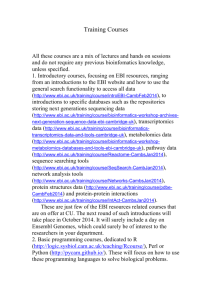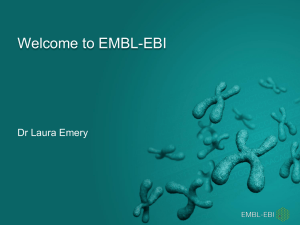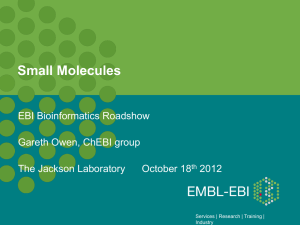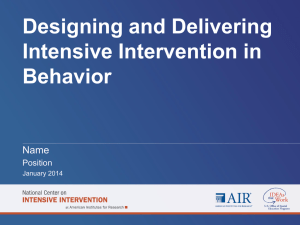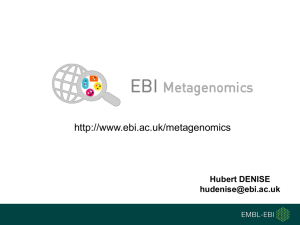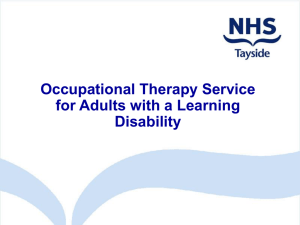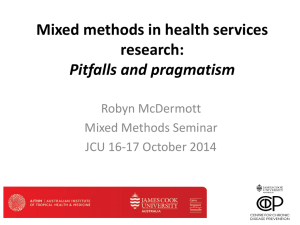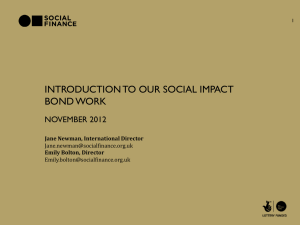Powerpoint Overview of the EBI Network - Evidence
advertisement
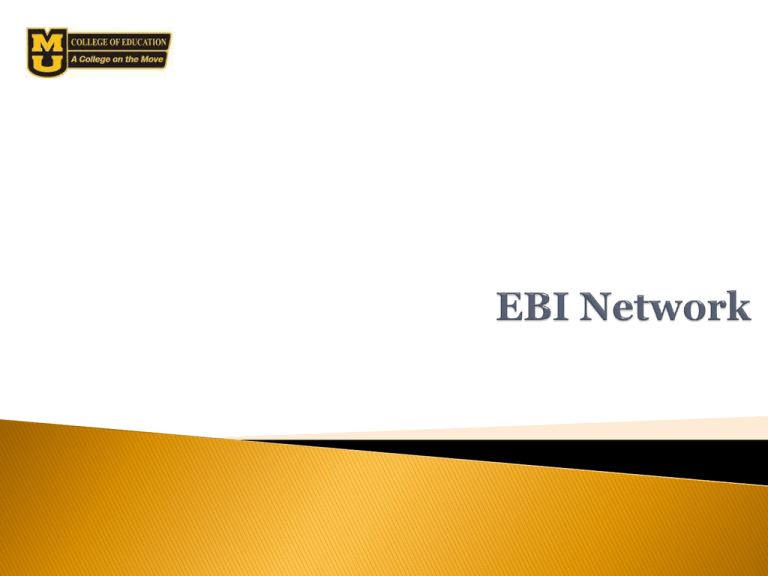
1) Problem Solving Models (RTI or PBS) essentially mean interventions for everyone in need ◦ Essentially any child not responding is considered in need. 2) No Child Left Behind and IDEIA mandate accountability, or that we have defensible outcome data on all interventions 3) Traditional models have been focused on spending a great deal of time coming up with recommendations about a child's needs ◦ Assessment orientation – Hours of assessment and report writing followed but meeting time ◦ Traditional Consultation orientation – A number of consultation sessions allowing a consultee to come up with intervention idea Design interventions at Tier 1, 2 and even 3 quickly Collect data in a highly feasible manner A consistent manner of data analysis that is quick and easy for anyone to do So… ◦ More cases ◦ Higher levels of accountability ◦ And traditional methods assume there is lots of time… Time is a precious commodity. Educators need to be efficient when problem solving. Under many circumstances, the most efficient thing to do is to test the easiest hypothesis first, implement an intervention, and monitor and evaluate outcomes. If that approach fails to improve student performance, then something progressively more time intensive can be attempted until the probable cause of failure is identified. ◦ Also, easier solutions are more likely to be implemented consistently while solutions which are more time consuming or technically difficult for teachers and support personnel are less likely to be implemented correctly (Gresham, 1989). Evidence-based interventions (EBI) are treatments that have proven effective through rigorous outcome evaluations History of EBI across professions ◦ Medicine, Clinical and Counseling Psychology, Education/School Psychology Where is the list? ◦ While we will talk about some reputable sources, there is no official list at this point Tier I EBI – Whole school best practices Tier II EBI – Functionally Related Small Group Practices Tier III - Individually Functionally Based EBI NOTE – EBI are a very different thing in Tiers 1 and 2 than Tier 3! This is a critical and not well understood issue… Tier 3 (5%) Functionally Based EBI Tier 2 (15%) Functionally Related Small-Group and Individual EBI Tier 1 (80%) Evidence-Based Curricula Doing What Works by the US Department of Education What Works Clearinghouse by the USDOE Institute of Education Sciences ◦ http://ies.ed.gov/ncee/wwc/ EBI are validated for a specific purpose with a specific population Implication ◦ EBI are only useful for a range of problems and as such, must be paired up with the right situation A hammer is an effective tool, but not with a screw EBI assumes implementation integrity Implication ◦ Changing parts of an intervention, while typical, can invalidate the EBI ◦ Ways to change an intervention Frequency Materials Target Style On and on and on…. EBI are typically validated with large group research, or a series of small group studies Implication ◦ EBI have been documented as likely effective, not surely effective ◦ Even the most effective interventions are often ineffective with a specific case ◦ As such, you cant assume an EBI will always work A list of EBI is just a nice place to start Additional steps ◦ Need to select EBI that make sense for the current case ◦ Need to implement the EBI with integrity ◦ Need to evaluate the effectiveness in some manner to see if it worked Created and maintained by the MU, IU and ECU School Psychology Programs Presents EBI associated with the 5 common reasons for academic and social behavior problems each year http://ebi.missouri.edu Using this model, a teacher or problem solving team is asked to consider what they think the most likely reasons are for the academic or behavior problems. ◦ Once selected, these hypothesized reasons are then used to select interventions. ◦ If there are more than one likely reasons selected, they should be rank ordered (from most to least likely). Selected interventions should be customized to the teacher with care not to alter the function ◦ Change the icing – not the core ingredients Implement Collect Outcome Data Analyze The true documentation that an intervention is "evidence based" for a specific case occurs only when there is outcome data indicating a change in the target behavior. 1. 2. 3. 4. 5. Classwide problems Student has not learned the behavior Inappropriate behavior removes student from what they do not want to do (escape) Inappropriate behavior gets the student something (typically attention) They have not had to do the behavior in that way before Sometime multiple children in the classroom are exhibiting similar behavior problems. Solution: A classwide behavior intervetion! EBI Network Intervention: Good Behavior Game ◦ http://ebi.missouri.edu/wp-content/uploads/2011/09/Good-BehaviorGame.pdf It is often assumed that at some level, student “knows” how to behave but simply chooses to misbehave. This assumption must be tested! Solution: Teach the appropriate behavior EBI Network Intervention: Sit and Watch ◦ http://ebi.missouri.edu/wp-content/uploads/2011/09/Sit-andWatch.pdf PBIS has an excellent school wide model of this. ◦ Teach Rules in the Context of Routines Teach expectations directly. Define rule in operational terms—tell students what the rule looks like within routine. Provide students with examples and non-examples of rule-following within routine. Actively involve students in lesson—game, role-play, etc. to check for their understanding. Provide opportunities to practice rule following behavior in the natural setting. ◦ Prompt or Remind Students of the Rule Provide students with visual prompts (e.g., posters, illustrations, etc). Use pre-corrections, which include “verbal reminders, behavioral rehearsals, or demonstrations of rule-following or socially appropriate behaviors that are presented in or before settings were problem behavior is likely” (Colvin, Sugai, Good, Lee, 1997). The problem behavior is “working” for the child by allowing them to escape something they don’t want to do. Solution: Minimize need for the escape! EBI Network Intervention: Antecedent Modifications ◦ http://ebi.missouri.edu/wp-content/uploads/2011/04/ClasswideAntecedent-Modifications-2.pdf The problem behavior is “working” for the child in some manner. Solution: Minimize reinforcement for problematic behavior while reinforcing appropriate behavior EBI Network Intervention: Response Cost Raffle ◦ http://ebi.missouri.edu/wp-content/uploads/2011/09/TheResponse-Cost-Raffle.pdf They do not want to do it 1. ◦ Motivation Interventions They have not spent enough time doing it 2. ◦ Proficiency/Speed Interventions They have not had enough help to do it 3. ◦ Proficiency/Accuracy Interventions They have not had to do it that way before, or 4. ◦ Generalization Interventions It is too hard 5. ◦ Acquisition Interventions Is the student not able to perform the skill (a skill deficit) or is the student able to perform the skill, but "just doesn't want to“ (motivation deficit)? Solution: Increase student interest by providing choices and incentives. EBI Network Intervention: Mystery Motivator ◦ http://ebi.missouri.edu/wp-content/uploads/2011/09/MysteryMotivator.pdf Fluent academic behavior takes practice, practice, practice! Solution: Increase the amount of time that a child can actively engage in a particular academic activity at their instructional or mastery level EBI Network Intervention: Partner Reading ◦ http://ebi.missouri.edu/wp-content/uploads/2011/03/ECUEBI-Academic-Need-Practice-Partner-Reading.pdf Feedback for student responses may be necessary to assist a student to respond accurately and quickly. Solution: Increase performance feedback individually or consider use of a group method (e.g. response cards) ◦ If accuracy, use modeling, prompting, and error correction strategies ◦ If fluency, use practice and reinforcement strategies EBI Network Intervention: Cover Copy Compare ◦ http://ebi.missouri.edu/wp-content/uploads/2011/04/ECU-EBIAcademic-Need-Help-Cover-Copy-and-Compare.pdf The students have demonstrated the skill before, but are having difficulty applying the skill in a new manner. Solution: Design tasks to apply skill, and promote recognition of when to apply the skill (and when not to). EBI Network Intervention: Reinforce Natural Occurrences ◦ http://ebi.missouri.edu/wp-content/uploads/2011/04/ECUEBI-Academic-Generalize-Reinforce-Natural-Occurrences.pdf Finally, the student might not be successful because the instructional materials are too difficult. Solution: Lower the task difficulty EBI Network Intervention: Instructional Match ◦ http://ebi.missouri.edu/wpcontent/uploads/2011/03/ECU-EBI-Academic-TooHard-Instructional-Match.pdf Where to Find More Interventions ◦ In the classroom (Riley-Tillman and Chafouleas, 2003) Certain treatments are more effective Certain treatments are more relevant Treatment integrity is key Interventions need to be tailored Interventions are more variable than effective Texts such a Rathvon’s Effective School Interventions Web resources for evidence-based intervention strategies ◦ Big Ideas in Beginning Reading (U of Oregon): http://reading.uoregon.edu/ ◦ What Works Clearinghouse (US Dept of Education): www.w-w-c.org ◦ Intervention Central: www.interventioncentral.org T. Chris Riley-Tillman, Ph.D. Educational, School, and Counseling Psychology 16 Hill Hall University of Missouri Columbia, MO 65211 education.missouri.edu/faculty/ESCP/Riley-Tillman_T.Chris.php Direct Behavior Rating: www.directbehaviorratings.com Evidence Based Intervention Network: ebi.missouri.edu
